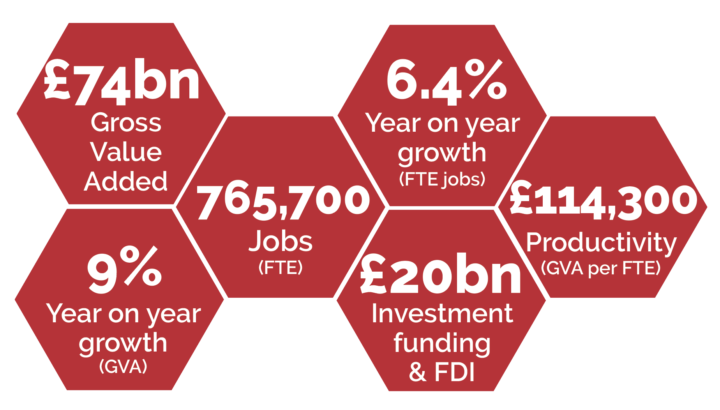The UK’s net zero economy
Ahead of election, key battleground seats three times more likely to be net zero economic ‘hotspots’
Last updated:
This new report - commissioned by us, with analysis provided by CBI Economics and The Data City - found that:
- The UK’s net zero economy grew 9% in 2023
- Total gross value added (GVA) by businesses involved in the net zero economy now stands at £74 billion.
- Jobs in the net zero economy are highly productive, generating £114,300 in economic activity
- Net zero jobs are better paid by almost £10,000, the average net zero salary being £44,600 compared to the £35,400 UK average.
The scale of the net zero economy
Net zero activity already forms a key part of the UK economy, creating innovation-led, high-value employment opportunities and attracting foreign direct investment.
The net zero economy spans a number of new and emerging sectors, such as renewables, carbon capture, or green finance, as well as more traditional, established sectors, such as manufacturing.
This latest analysis shows that these businesses contributed £74 billion in Gross Value Added (GVA) in 2022-23, which is equivalent to 3.8% of the UK economy – larger than the economy of Wales (£66 billion). They also supported 765,700 Full Time Equivalent (FTE) jobs, equal to nearly 3% of total UK employment.
Their contributions include the value generated by their own activity (£25 billion) and their employees (218,500 jobs) as well as the wider economic contributions they supported through their expenditure with suppliers and the expenditure of their employees on goods and services. In essence, due to these wider spillover benefits, for every £1 million in GVA contributed by net zero businesses, nearly £2 million more was added through these wider economic contributions.

Key electoral battlegrounds
Looking at the economic opportunities the sector contributes at parliamentary constituency levels, we found that 65% of the top 25 net zero hotspots and half of the top 50 net zero hotspots in England and Wales are classified as key electoral battlegrounds heading into the general election. Moreover, Conservative-held electoral battlegrounds are found to be more than three times more likely to be areas of extremely high net zero economic activity.
Many of the constituencies (44%) that were made up of significant proportions of the net zero economy (top 25 hotspots) were found in the East Midlands. Derby North and North West Leicestershire were the most prominent net zero hotspots in the region that were also electoral battlegrounds, with the net zero economy accounting for 9% and 8% of their respective local economies. However, there was also an extremely strong pocket of activity in the North West. South East Manchester is home to three of the most prominent net zero hotspots, with contributions of 16% of local GVA across these areas. Of these, two are considered to be electoral battlegrounds (Cheadle and Hazel Grove).
Many local economies in Scotland also have a significant proportion attributed to the net zero economy.6 Aberdeen was a stronghold for net zero economic activity, with the net zero economy in both Aberdeen South and Aberdeen North contributing over 10% of local employment (11.8% and 10.5% respectively).
Constituency data
There is no north/south divide in the economic opportunities created by the net zero economy, with all UK regions benefitting.
You can use our interactive heatmap to find the Gross Value Added GVA) and jobs for different constituencies. The England and Wales map shows new constituency boundaries, while Scotland uses existing boundaries.
Case studies: local net zero businesses across the UK
Click the arrow to view all the case studies - you may need to scroll up or down to view more case study text.
